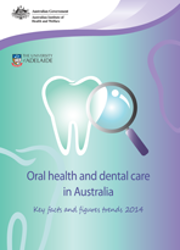Summary
This report highlights key trends in the oral health and dental care of the Australian population using the most recently available data. It is the latest in the Oral health and dental care in Australia: key facts and figures suite of printed publications and web products.
Oral health
The major measures of oral health in Australia suggest that there have been improvements over the long term. In recent years, however, there is some indication that the positive trends have either plateaued or have begun to head in a negative direction. For example:
- From 1977 to 1995, data from examination of school-aged children in school dental services suggests there was a steady drop in the average number of children's baby teeth affected by decay. There has, however, been a gradual rise from 1996.
- Between 1987-88 and 2004-06, national surveys reported a decrease in the average number of teeth affected by decay (caries experience) in adults.
- From 1994 to 2010, the proportion of people aged 15 and over reporting any adverse oral health impact generally rose from survey to survey, with exceptions in 2002 and 2010. The proportion ranged between 31.4% (1994) and 39.9% (2008).
Dental care
In contrast to the recent negative trends in oral health, the trends in dental visiting patterns have generally been more positive.
The proportion of people aged 15 and over who made a dental visit in the previous 12 months increased from 56% in 1994 to 62% in 2010.
The proportion of adults with a favourable visiting pattern generally rose from 36% in 1999 to 46% in 2010. Despite this, cost of dental care remains a barrier for some. According to the National Dental Telephone Interview Survey, from 1994 to 2010, there was an increase in the proportion of adults avoiding visits to a dentist due to costs, from about 25% to 30%.
There has been a recent growth in the supply of dental practitioners that may have an influence on the availability of dental care across the population. Between 2011 and 2012, the number of dental practitioners employed increased from around 18, 700 to nearly 19,600. Over this period, the full-time equivalent rate of dentists per 100,000 population rose from around 55 to 57 dentists.



